Ankle Sprain
An ankle sprain is a very common sports injury. A sprain refers to the tearing of ligaments in a joint. The joint in this case is the ankle. The ligaments are tissues which connect bones or cartilage in the joint. The ligament tear can be slight or severe and can include one or several ligaments. Most ankle sprains are not severe and can heal well if properly treated, permitting a safe and early return to activity. Severe ankle sprains require specialized care and can often develop into a chronic problem, such as chronic ankle instability. The ligaments of the ankle are shown below.
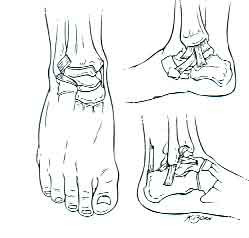
Anatomy
Three important ligaments cross the lateral (outside) aspect of the ankle joint and are the most commonly injured with ankle sprains.
- Anterior Talofibular (ATF) Ligament
- Posterior Talofibular (PTF) Ligament
- Calcaneo Fibular (CF) Ligament
- On the medial (inside) aspect of the ankle joint is the deltoid ligament, which is composed of several ligaments. The deltoid ligament is less commonly injured.
- Deltoid Ligament
Mechanisms of Injury
The injury is usually the result of twisting the ankle. In sports, the ankle twist can occur with sudden pivoting or cutting movements. The most common sprain involves an inward twist of the ankle, usually injuring the ATF and CF ligaments. Contributing factors for ankle sprains include previous injury, weak or imbalanced muscles, inappropriate or worn out shoes, uneven surface, overweight, or family tendency.
Classification of Ankle Sprains
Three degrees of severity are used to grade ankle sprains. The more severe the sprain, the longer the time to recover.
- First Degree:
This is the most common sprain and is a minor injury if not neglected. The ligaments are stretched, not torn. There may be mild swelling, but no instability. The athlete can expect to resume sports in 1 – 2 weeks with conservative therapy. - Second Degree:
The ankle ligaments are partially torn, causing bleeding, which results in ankle pain, swelling, bruising, and discoloration. Treatment requires ankle immobilization in a brace, splint, or similar device. Recovery may take 3 – 6 weeks. - Third Degree:
The ankle ligaments are more severely torn, causing instability. Recovery is much longer for a third-degree sprain, requiring 8 – 12 months for the ligaments to fully heal.
Treatment
For immediate treatment of the ankle sprain, use the RICE approach.
RICE
Which stands for Rest, Ice, Compression, and Elevation.
REST: Avoid weight-bearing on the ankle. Use crutches when standing and walking.
ICE: Ice can be applied as an ice pack, an ice bath, or an ice massage. Ice decreases the swelling, pain, bruising, and muscle spasm. Use ice for 20 minutes, 4 – 6 times per day, for 3 days after the injury.
COMPRESSION: A tense wrap of the ankle will help lessen the swelling and bruising. Ankle braces and stabilizers can provide both compression and stabilization of the torn ankle ligaments. See examples of these devices in the Sports Med Store. Length of time for using such devices will depend on the degree of the sprain.
ELEVATION: Raising the ankle above the level of the heart can help reduce swelling and bruising. Keep the ankle elevated for about 2 – 3 hours per day if possible.
Rehabilitation of an ankle sprain involves a treatment program which is divided into four stages. The rate of recovery depends upon the severity of the sprain; the amount of pain, swelling, and instability; and whether tape, splint, brace, cast boot, or cast is used to immobilize the ankle.
- The initial phase of treatment, Stage 1, includes the RICE treatment program and lasts up to three days. Pain medication, such as Tylenol or ibuprofen, or a prescription analgesic, may be recommended or necessary. Crutches may be necessary when the athlete is ready and comfortable to start walking. Crutches help prevent weight-bearing on the injured ankle, thereby reducing the pain caused by walking.
- Stage 2 of treatment usually lasts up to the first week. The ankle is supported by an appropriate device. Crutches are used but relied upon less. Activity is allowed and is increased as long as it is tolerated. Range of motion (ROM) exercises are strongly encouraged, even with the ankle support in place. Such exercises help overcome and prevent additional ankle stiffness. An example of ROM exercise is resting the heel on floor, using the big toe to write the alphabet in the air, and making the letters as large as possible. Contrast soaks, using hot water, then ice water, 5 minutes each, for two times each, helps relieve residual ankle swelling and stiffness.
- Stage 3 of treatment usually lasts up to the second week or longer. The ankle is moved and exercised to help it regain its flexibility and strength. With proper instruction, the athlete will do such ankle exercises at home. A referral to a physical therapist may be necessary to assist the athlete, making use of specialized equipment and other treatment modalities.
- Complete rehabilitation of an ankle sprain, which is Stage 4, may take several weeks to months. The injured ankle is made strong enough for the athlete to return to his sport without restrictions or risks for re-injury. The athlete first tests the ankle by standing on his toes for 20 seconds, hopping up and down on his toes 10 times, and running on his toes. Once this is accomplished, the athlete can begin jogging in a straight line, then progress to running. As the ankle becomes stronger, the athlete can start running large figures of 8. Then, he can cut and zigzag. When the athlete can zigzag without ankle pain or instability, he is ready to return to his sport. The ankle should be supported for a minimum of six months after injury. Taping the ankle or using a lace-up ankle brace may help prevent re-injury.
Athletic shoes that fit well are better for stabilizing the foot and minimizing slippage. Such shoes should have strong, flat, even soles that are neither too spongy nor too thick. Sports such as volleyball, basketball, football, and racquetball are associated with the highest rate of ankle sprains.
Exercises With Resistance
Obtain a strip (about two feet long) of elastic belting material, TheraBand surgical tubing (from the Sports Med Store), or a bike tire inner tube. Work your ankle in four directions as shown. As you do each tube exercise, pull the tubing taut, heel on the floor, and make sure you do the exercises only with your foot and ankle, not your whole leg. The tube should be placed at the base of your toes.
Repeat each exercise 10 times, 2 times/day.
OUT AND UP
Sit on floor or chair. Loop tubing over foot and around table leg. With heel on floor, work ankle out and up.
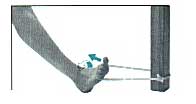
IN AND UP
As before, but loop tubing to provide tension against an inward move. With heel on floor, work ankle in and up.
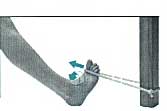
STRAIGHT UP
Loop tubing over foot and around a table leg. With heel on floor, work ankle straight up.
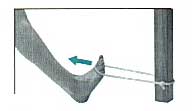
STRAIGHT DOWN
Hold tube loop with hands against bottom of foot. With heel on floor, work ankle down
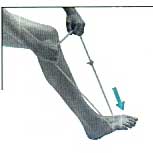
HEEL RAISE
Stand on one foot, slowly rise on toes, and slowly lower heel to the floor. Progress to doing this exercise on the edge of a step.
Repeat 15 times, 2 times a day.
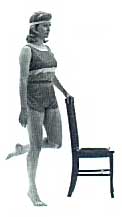
General exercises. Swimming with swim fins and riding bicycle or exercycle can provide an excellent workout for your calf and ankle.
Exercising will strengthen muscles that support the injured area and help prevent re-injury and chronic problems. Do each prescribed exercise two times a day or more often if necessary.
Stretches
Do stretches before and after activity. Lean against a table with your back knee locked and your front knee bent. Press forward until a moderate stretch is felt in the calf muscles of your straight leg. Hold 15 seconds. Keeping both heels on the floor, bend the knee of your straight leg until a moderate stretch is felt in your Achilles tendon. The Achilles tendon is the lower portion of the calf muscle which attaches to the heel bone. Hold 15 seconds. You should feel a moderate pull, but no pain. Change legs and stretch the other leg. Repeat 15 times, 2 times/day.
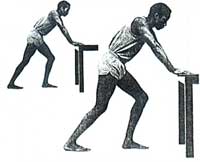
I cannot give medical advice about how to treat a specific injury without evaluating the athlete first. While I may discuss general exercises to prevent and treat sports injuries, not all exercises are designed for all individuals or problems. A sports medicine physician should be consulted before starting any exercise program. If an athlete is experiencing any severe pain or discomfort, he should see such a physician and obtain a specific diagnosis and treatment plan. The exercises outlined here are general recommendations and are not intended as a substitute for professional medical advice.
Specialty Reference
Foot & Ankle Center